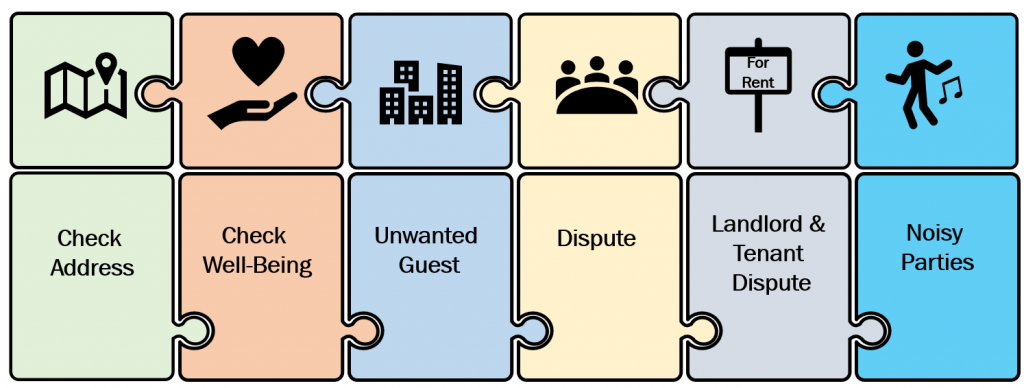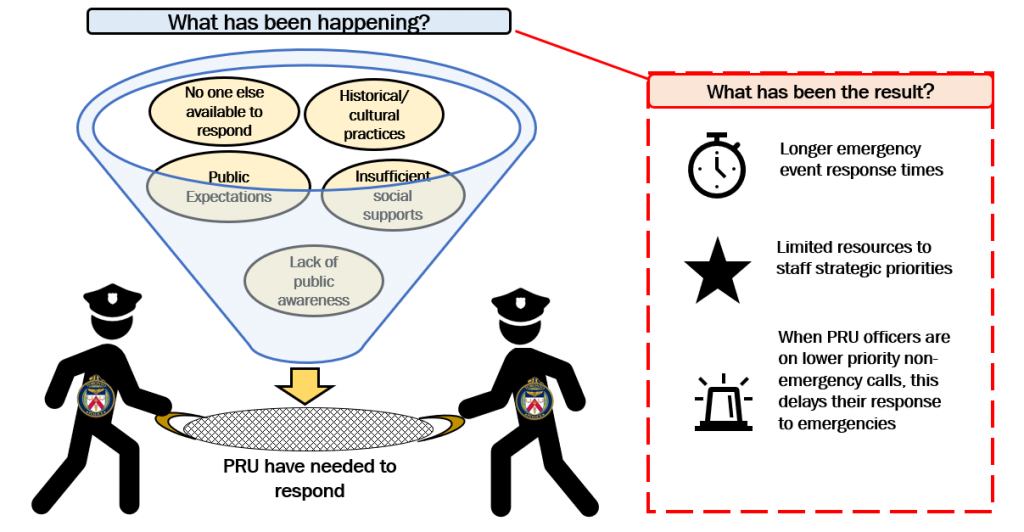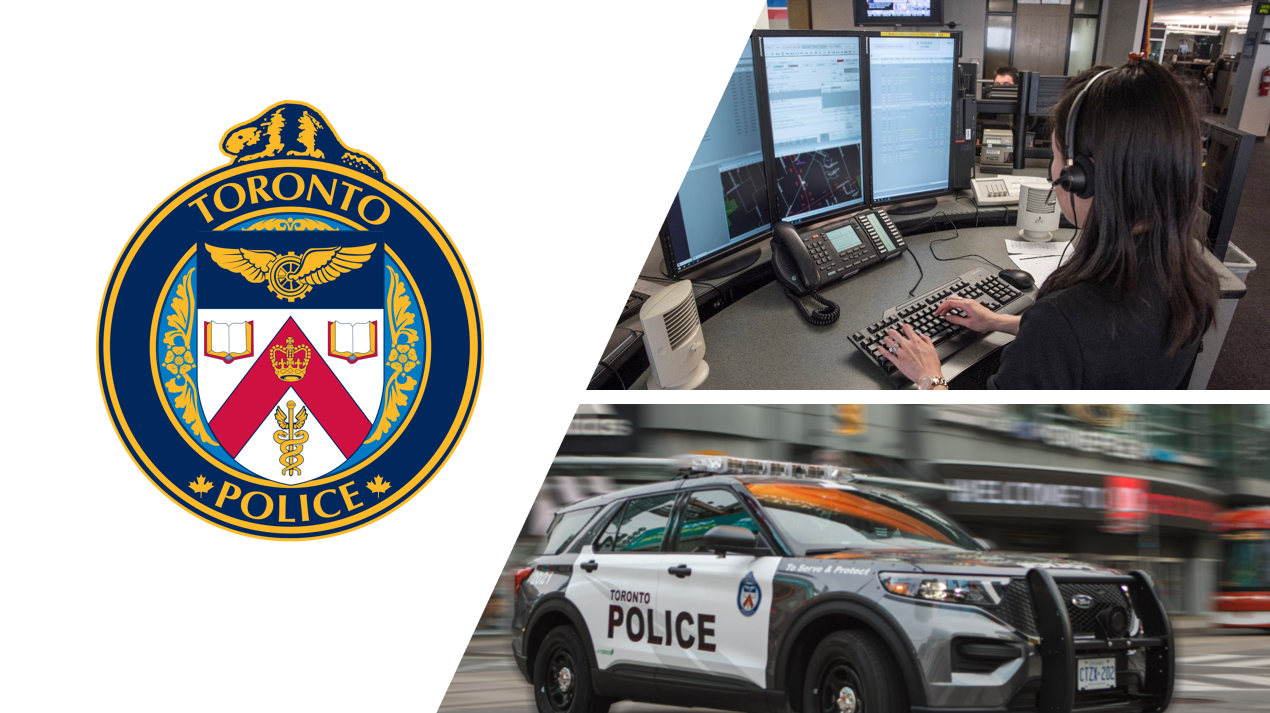PDF version of the ‘At a glance’ for this report
Why This Review Matters
In a city with almost 3 million people, demand for police resources is high. Response times are increasing and the Toronto Police Service (TPS) must determine the most efficient and effective allocation and use of its front-line priority response unit (PRU) officers. At the same time, the City and TPS must work together and develop effective and timely alternative non-police responses where appropriate, that provide the best possible outcomes for the people of Toronto, especially those who are the most vulnerable.
By The Numbers
- 47%: Percentage of low priority (priority 4 to 6) non-emergency calls for service dispatched to front-line officers in 2019.
- 40%: Calls for service in six lower priority event types (shown below) that could have been handled by alternative responses if proper alternative responses were in place. (the % cannot be extrapolated to all lower priority or all dispatched calls)

- 85,000 hours over 5 years: estimated PRU officer time that could be reallocated if alternative responses were in place at the times needed.
- 26,000: ‘See Ambulance’ calls dispatched for PRU to attend in 2019, one of the highest event types. Some may not have needed a PRU officer.
- 19 and 50 minutes: average response times for priority 1 and priority 2 calls for service in 2019.
- 6 minutes: TPS response time targets for priority 1 and 2 calls. These targets were approved by the TPS board in 1995.
What We Found
A – Re-thinking Call for Service Response to Support More Efficient and Effective Outcomes
- PRU officers have become the default response for responding to some calls where police may not be needed, and community-based responses could provide a better outcome. They often respond because:
1. They are called to respond. The public often expects an immediate assistance, including for non-emergency calls for service.
2. Alternative non-police responses are not always in place or not available when needed (e.g. 24/7)

- TPS has experienced increasing response times over the last several years and is not meeting its response targets.
- For ‘See Ambulance’ calls for service, police are often requested to attend when a safety risk has not been clearly articulated. The protocol should be re-visited and updated.
B – Improving and Further Leveraging Technology and Data
- TPS needs to better capture and analyze data to be able to identify calls for service that are suitable for alternative responses and to improve workforce management. Diverting calls to alternative responses could also help to improve response times for high priority emergency calls for service, while ensuring the most appropriate resource is providing the most effective response to help ensure positive long-term outcomes.
- TPS should further leverage technology to help divert non-emergency calls, automate processes, free-up PRU officer time and improve efficiency.
C – Increasing Integration and Information Sharing
There are opportunities for TPS, the City and other agencies to increase collaboration including:
- sharing and using data (e.g. Toronto’s Community Crisis Service response pilot, 3-1-1 , 2-1-1, and other community agencies), to identify preventative actions and to support opportunities for alternative responses.
- TPS should also develop strategies to reduce PRU officer time spent waiting in hospitals related to mental health apprehensions.
Funding Supports
- In our view, based on the results, it is not a ‘lift and shift’ of calls for service and funding, but a strategy of gradual transition for alternative non-police responses where appropriate, with the shared goal to improve outcomes for the people of Toronto.
- These are complex matters needing better information to support transition. Opportunities for alternative responses may grow over time as better information is captured and analyzed, and while alternative responses are piloted and evaluated for potential further roll-out.
- Once the pilots for alternative non-police responses have been established and evaluated, which will take several years, funding levels and sources should be re-assessed. Other factors impacting both TPS and the City should also be considered, including the population growth, the demand level to meet the needs of vulnerable people, strategic priorities and resourcing to achieve them, as well as other considerations such as the impact of mandated NG9-1-1 requirements.
- This review also highlights that a whole-of-government and a whole-of-community commitment and approach is needed. Strategic investment by all levels of government in social service infrastructure and alternative strategies is necessary in order to create long-term value for individuals, the community and the City. The need for funding supports from other levels of government for social infrastructure is also supported by our recent audits of the City’s shelters.
How Our Recommendations Will Benefit TPS, The City, and the People Of Toronto
Achieving better outcomes for the people of Toronto and improving response times, especially for emergency calls, will require collaboration and leadership. The 25 recommendations in our report provide key stakeholders with a starting point that will support them on their journey of long-term change as TPS works with the City and other stakeholders to move forward together.
The following will be important to achieve the change needed:
- identifying key and shared outcomes as part of strategic planning and collaboration and use evidence-based data to inform decisions
- being transparent and accountable by tracking and reporting out publicly on progress against agreed plans and outcomes
- being committed and building trust and support between stakeholders as they move through any barriers and difficulties towards common goals.
